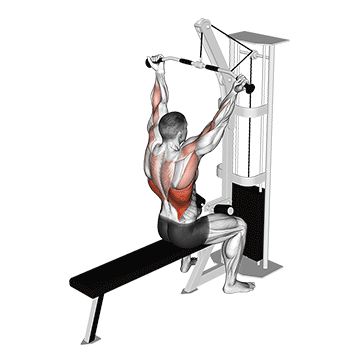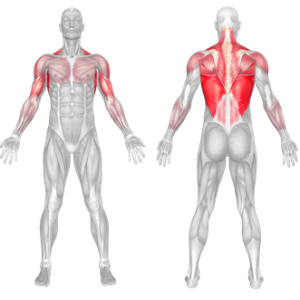Wide-Grip Reverse Lat-Pulldown / Supinated Lat Pulldown
The reverse lat pulldown primarily targets the muscles of the upper back, especially the latissimus dorsi, teres major, and rhomboids. It also engages the biceps to a greater extent than the traditional lat pulldown. This variation can provide a different stimulus to your back muscles and help improve overall back development.
How to do:

- Set Up:
- Adjust the seat on the lat pulldown machine so that your thighs are secured under the leg pads.
- Grasp the bar with a reverse grip, with your palms facing you and your hands slightly wider than shoulder width.
- Body Position:
- Sit down with your back straight and your chest up.
- Keep your feet flat on the floor. Hold the bar with a firm grip.
- Movement:
- Start with your arms fully extended overhead.
- Pull the bar down towards your chest by bringing your elbows down and back.
- Focus on squeezing your shoulder blades together as you bring the bar down.
- Lower the bar in a controlled manner to the starting position without letting the weight stack touch.
- Breathing:
- Inhale as you extend your arms overhead.
- Exhale as you pull the bar down.
Tips:
- Keep your torso stationary; avoid leaning back excessively.
- Focus on using your lats to initiate the movement.
- Control the weight throughout the entire range of motion.
Reverse Lat-Pulldown Benefits
- Targeted Muscle Engagement:
- The wide reverse grip emphasizes the muscles of the upper back, particularly the latissimus dorsi. Changing the grip width alters the way muscles are recruited during the exercise. A wider grip may place more emphasis on the outer portions of the lats and the upper back.
- Biceps Engagement:
- The reverse grip not only works the back muscles but also engages the biceps to a greater extent compared to traditional overhand lat pulldowns. This can be beneficial for those looking to develop both their back and biceps.
- Reduced Shoulder Stress:
- Some individuals find that the reverse grip places less stress on the shoulder joints compared to a pronated (overhand) grip. This can be advantageous for those who may have shoulder issues or discomfort during overhand lat pulldowns.
- Improved Grip Strength:
- The reverse grip challenges your grip strength in a different way compared to the overhand grip. This can contribute to overall forearm and grip strength development.
- Scapular Retraction and Posture:
- Performing lat pulldowns with a reverse grip encourages scapular retraction, which is essential for good posture. Strengthening the muscles responsible for scapular movement can contribute to better upper back posture.
- Adaptability for Different Fitness Levels:
- The reverse lat pulldown can be adjusted to suit various fitness levels by adjusting the weight on the lat pulldown machine. This makes it suitable for beginners and advanced lifters alike.
Reverse Lat-Pulldown – Muscles Worked

